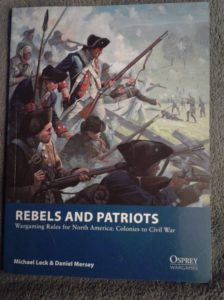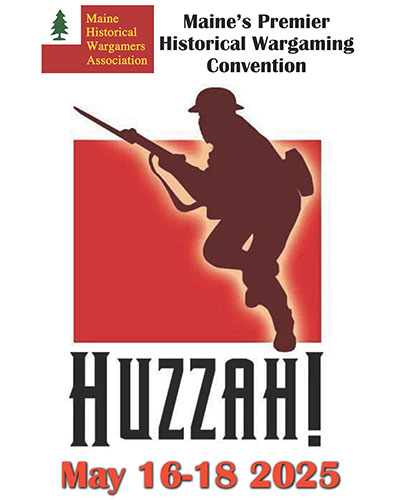Rebels and Patriots
Author: Michael Leck & Daniel Mersey
Publisher: Osprey Games
MSRP: $20.00 US ($13.66 on Amazon via our affiliate link)
Period/Setting: North America: Colonies to Civil War. Generally 1754-1877
Scale: scale-neutral. Rules advise 15mm-28mm. Other scales can be used, but you might have to make a few changes if you wish.
Basing: Infantry: individual 25mm round bases. Cavalry: 40mm round. There are included rules for multi-basing and how to use them.
Game Board: 48″x48″
Army size per side: 24 points worth of figures. One unit can be between 2 and 10 points. Approximately 40-60 figures.
Primary dice: D6. Rolling either 12, 6 or 2 dice. Rolling higher is better.
Overview:
This 64-page ruleset is part of the Osprey Wargames blue book series.
If you have played any of Dan Mersey’s other Rampant series (such as Dragon or Lion Rampant) of games, then you will have a good idea as to how this game generally works. There are some rule changes to update for the time period. I have only played a few games of Dragon Rampant at conventions, so I am not able to speak to all the changes.
If you have not played any of his other games; then you should know that it is an I Go, You Go (IGO-UGO) system with individual unit activation. Players roll 2d6 looking for a 6+ to activate your unit. One of the changes from the earlier Rampant series games is that you can try to activate each unit before your turn ends. This is instead of ending your turn at a failed activation. You are usually looking for 6’s to wound you targets and figures are removed for every 2 or 3 success you get. As wounds are dealt to a unit you remove individual figures in the effort to rout or break the unit.
The book:
I found that this book was very well written, easy to follow, and needed rules were quickly found.The book starts with a very useful table of contents. It made finding rules very easy, especially since there is no index.
The first section is a quick introduction to the game. In it the authors talk about what you will need to play. They also mention how they tried to keep rules to a minimum while also allowing for a more Hollywood style of play.
The next section covers building your force to play a game. This goes over your officer, how they gain traits, and improve during a campaign by gaining honour. Next, the units of troops are covered. You can bring in everything from skirmishers to heavy artillery to shock cavalry. With each unit you can take different upgrades to make them better represent your chosen force. For example, if you pick veteran it will raise the unit’s discipline. You could use this upgrade to represent a fanatical unit instead of a veteran unit. Each unit has its own stat line to represent how well the unit can shoot, fight or stay in combat. Most units can move as a “blob”, have 360 vision, and target anything around them. Infantry in line formation and artillery are the only real exceptions to this.
The third section contains the rules for battle. This is the meat of the book, since it covers everything you do with your opponent. It covers how you activate each unit and what they can do on their activation all the way to how units are wounded and removed from the game.
The fourth section is for the 12 scenarios. Each scenario tells you how the board should be set up. Then it lists any special rules you might want to remember. Next up, is how the scenario ends; followed by the objectives, so you can tally up the honour on both sides to determine a winner. The honour will be awarded to your commander. It can rank them up whereby they can learn another trait.
Found in the fifth section is a list of sample companies for the wars covered by this book. They are generic companies to represent the participants in a particular war. You are almost expected to create your own forces or mirror them to a real-world company. If you plan to do that, then you need to do you own research about that company.
Final Thoughts:
This is a nice quick game system that lets you replicate fighting in North America for about a 100-year period. You can transport the rules to other areas and they will still work just fine. If you are looking for a lighter game in this period then you should give this look. If you are looking for a large game or technical or specialized then you might want to pass on this game.



